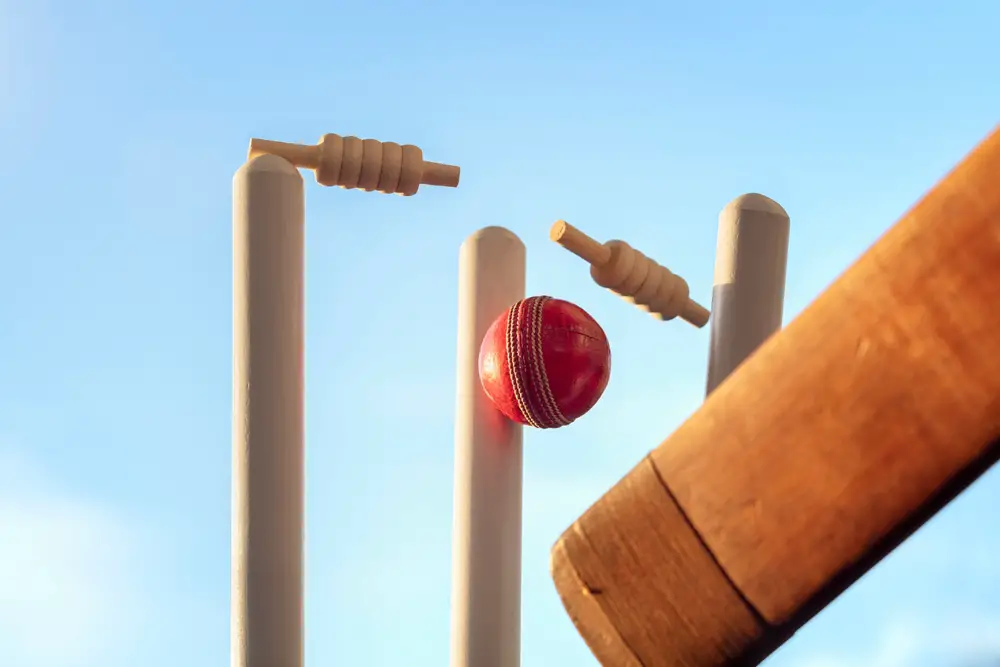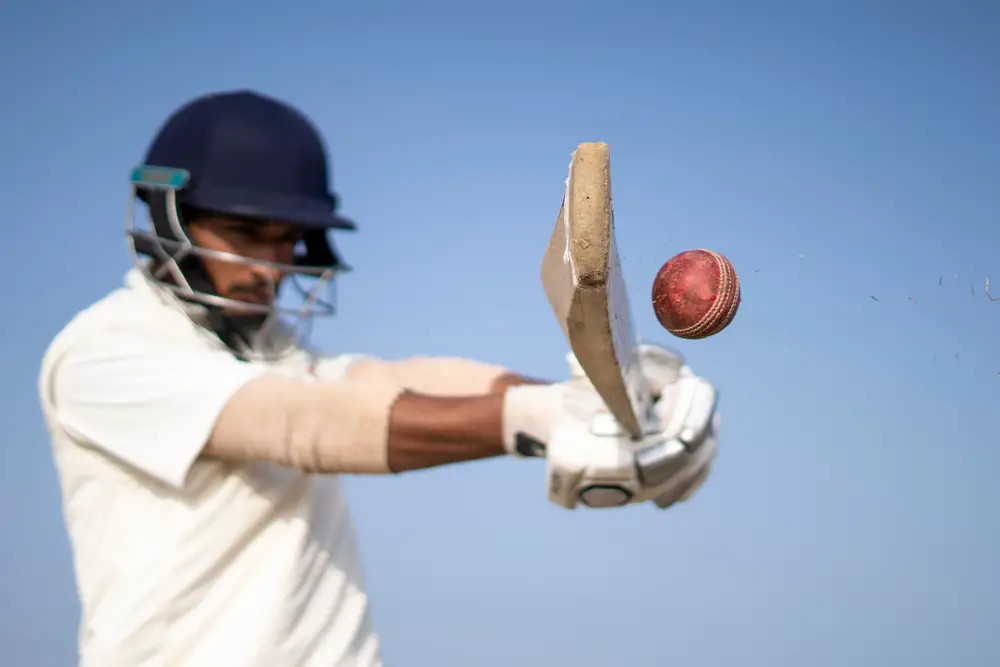Cricket is one of the oldest and most popular sports in the world. The sport is particularly popular in countries such as England, Australia, India and Pakistan, where there are more fans, either playing or just enjoying it;
As cricket is not so popular in many other countries, those who are interested in the sport need to be aware of the terms that make up the sport. With this in mind, we’ve come up with a solution: the cricket glossary.
With this list, you’ll discover the main terms used in sport and what each one means. This understanding will be crucial to understanding how the game works, whether you’re a player or a spectator!

So check out the glossary of cricket!
Open your Betano account and get up to 1,000 reais in bonuses.
Payments via PIX, live games and super odds!
Click here to open your account!
Cricket glossary: complete list
- All-rounder
- Appeal
- Bowling
- Batsman/Batter
- Bat
- Beamer
- Bola
- Bowl-out
- Century
- Runs
- Crease
- Duck
- Fielding
- Follow-on
- Full toss
- Goleiro (Wicketkeeper)
- Innings
- LBW (Leg Before Wicket)
- Maiden Over
- No Ball
- Out
- Over
- Pitch
- Powerplay
- Run-out
- Six
- Silly Point
- Spinner
- Umpire
- Wicket
Cricket glossary: learn more about the terms
All-rounder
An all-rounder is a player who is competent as both a batsman and a bowler. The presence of an all-rounder brings extra flexibility to the team, allowing for a better balance between attack and defense.
Appeal
An appeal is a verbal request made by the fielders to the umpire to declare a batsman out. This happens when the players believe that the batsman has infringed some rule of the game, such as being caught in the air or dropped.
Bowling
Bowling is the action of throwing the ball towards the batsman. Bowlers can use different techniques and styles, such as fast, medium or spin, each with their own strategies to try to eliminate the batsman.
Batsman/Batter
The batsman is the player who uses the bat to try to score runs. There are two batsmen on the field at the same time, each positioned on one of the wickets. They take turns batting while the ball is bowled.
Bat
The bat is the equipment used by the batsman to hit the ball. It is usually made of wood and has a flat blade and a handle. The design of the bat allows the batsman to improve control and power when striking the ball.
Beamer
A beamer is a type of illegal throw in which the ball does not bounce on the ground before reaching the batsman, but is aimed at head height or above. It is considered dangerous and can result in warnings or penalties for the bowler.
Ball
The cricket ball is made of cork and leather and weighs between 155.9 and 163 grams. The bowler tries to use the ball to bowl out the batsman, while the batsman tries to hit the ball to score runs.
Bowl-out
A bowl-out is a tie-breaker method used in some forms of cricket to decide the winner in the event of a draw. The bowlers try to hit the wickets with the ball, and the team with the most hits wins.
Century
A century is when a batsman scores 100 or more runs in a single innings. It is a great achievement and is celebrated as an important milestone in a batsman’s career.
Runs
Runs are the points scored in cricket. They are scored when batsmen run from one end of the pitch to the other after striking the ball, or when the ball hits the boundary of the pitch.
Crease
The crease is the white line marked on the cricket field that defines the areas where batsmen are safe from being run out. There are two main ones: the popping crease and the bowling crease.
Duck
A duck is when a batsman is dismissed without scoring any runs. A golden duck is when the batsman is dismissed on the first ball he faces.
Fielding
Fielding is the action of players in defense, trying to prevent the opposing team from scoring runs or eliminating batsmen. This includes catching the ball in the air, throwing for wickets and blocking runs.
Follow-on
The follow-on is a rule that allows the defending team to ask the opposing team to bat again, immediately after being eliminated, if the difference in runs between the two teams is large enough.
Full toss
A full toss is a delivery in which the ball does not bounce on the ground before reaching the batsman. Depending on the height of the ball, it can be an opportunity for the batsman to score runs or be considered an illegal throw.
Wicketkeeper
The wicketkeeper is the player who stands behind the wickets to catch balls that have gone past the batsman. He is crucial in eliminating batsmen through stumpings and catches.
Innings
Innings is the term used to describe the phase in which a team is batting. A cricket match can have one or two innings for each team, depending on the format.
LBW (Leg Before Wicket)
LBW is a form of dismissal in which the batsman is declared out if the ball that would have hit the wickets has hit the first batsman’s leg. This is one of the most technical forms of dismissal and often requires an umpire’s decision.
Maiden Over
A maiden over is a sequence of six pitches in which the bowler concedes no runs. It is an indication of effective bowling and pressure on the batsman.
No Ball
A “no ball” is a throw that infringes the rules, resulting in a penalty for the bowler and an extra run for the batting team. Exceeding the pitching line or throwing a beamer are examples of no balls.
Out
Out is the condition of a batsman who has been taken out of the game by one of the various ways of elimination, such as being caught, LBW, run out, among others.
Over
An over consists of six consecutive deliveries by the same bowler. After an over, a new bowler is designated and the game continues.
Pitch
The pitch is the rectangular area in the center of the field where the throwing and hitting takes place. It is 22 yards long and 10 feet wide, with wickets at each end.
Powerplay
Powerplay is a limited phase during a cricket match in which fielding restrictions are applied, usually in the first few overs of the innings. This favors the batsmen and increases the chance of scoring runs quickly.
Run-out
Run-out is a form of dismissal in which the batsman is out when the ball is bowled to the wickets before it can reach safe crease.
Six
A six is when the batsman hits the ball over the boundary without it touching the ground, resulting in six runs automatically.
Silly Point
Silly Point is a fielding position extremely close to the batter, on the off side, used to catch short defensive balls. It is a risky position due to the proximity of the action.
Spinner
A spinner is a bowler who specializes in bowling balls that spin, causing the ball to change direction after bouncing on the pitch. Spinners use different spin techniques to deceive batsmen.
Umpire
The umpire is the referee of the game, responsible for making decisions about the rules, judging appeals and maintaining order on the pitch. There are usually two umpires on the field during a match.
Wicket
The wicket is a set of three vertical stumps and two small horizontal bails placed on top. The bowler’s aim is to knock over the wicket to eliminate the batsman.

Cricket glossary: complete list
- All-rounder
- Appeal
- Bowling
- Batsman/Batter
- Bat
- Beamer
- Bola
- Bowl-out
- Century
- Runs
- Crease
- Duck
- Fielding
- Follow-on
- Full toss
- Goleiro (Wicketkeeper)
- Innings
- LBW (Leg Before Wicket)
- Maiden Over
- No Ball
- Out
- Over
- Pitch
- Powerplay
- Run-out
- Six
- Silly Point
- Spinner
- Umpire
- Wicket
Cricket glossary
If you enjoyed learning about the glossary of cricket and the main words used in the sport, take the opportunity to check out our other special content on the subject.
Here you’ll find lists, glossaries, rankings, special articles, news and much more about the world of sport!





